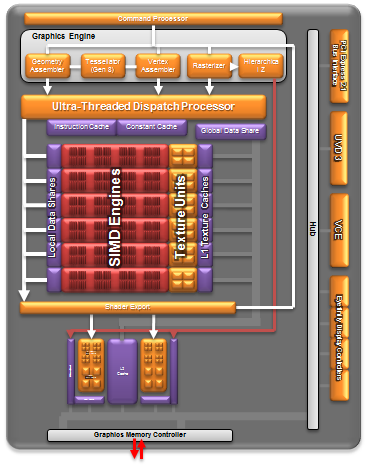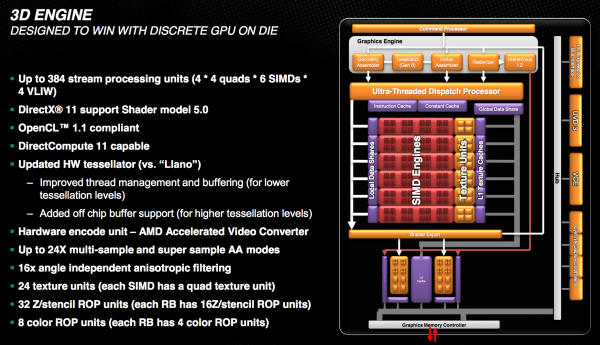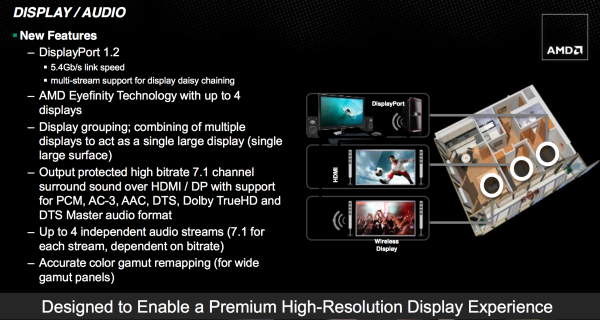The AMD Trinity Review (A10-4600M): A New Hope
by Jarred Walton on May 15, 2012 12:00 AM ESTImproved Turbo
Trinity features a much improved version of AMD's Turbo Core technology compared to Llano. First and foremost, both CPU and GPU turbo are now supported. In Llano only the CPU cores could turbo up if there was additional TDP headroom available, while the GPU cores ran no higher than their max specified frequency. In Trinity, if the CPU cores aren't using all of their allocated TDP but the GPU is under heavy load, it can exceed its typical max frequency to capitalize on the available TDP. The same obviously works in reverse.
Under the hood, the microcontroller that monitors all power consumption within the APU is much more capable. In Llano, the Turbo Core microcontroller looked at activity on the CPU/GPU and performed a static allocation of power based on this data. In Trinity, AMD implemented a physics based thermal calculation model using fast transforms. The model takes power and translates it into a dynamic temperature calculation. Power is still estimated based on workload, which AMD claims has less than a 1% error rate, but the new model gets accurate temperatures from those estimations. The thermal model delivers accuracy at or below 2C, in real time. Having more accurate thermal data allows the turbo microcontroller to respond quicker, which should allow for frequencies to scale up and down more effectively.
At the end of the day this should improve performance, although it's difficult to compare directly to Llano since so much has changed between the two APUs. Just as with Llano, AMD specifies nominal and max turbo frequencies for the Trinity CPU/GPU.
A Beefy Set of Interconnects
The holy grail for AMD (and Intel for that matter) is a single piece of silicon with CPU and GPU style cores that coexist harmoniously, each doing what they do best. We're not quite there yet, but in pursuit of that goal it's important to have tons of bandwidth available on chip.
Trinity still features two 64-bit DDR3 memory controllers with support for up to DDR3-1866 speeds. The controllers add support for 1.25V memory. Notebook bound Trinities (Socket FS1r2 and Socket FP2) support up to 32GB of memory, while the desktop variants (Socket FM2) can handle up to 64GB.
Hyper Transport is gone as an external interconnect, leaving only PCIe for off-chip IO. The Fusion Control Link is a 128-bit (each direction) interface giving off-chip IO devices access to system memory. Trinity also features a 256-bit (in each direction, per memory channel) Radeon Memory Bus (RMB) direct access to the DRAM controllers. The excessive width of this bus likely implies that it's also used for CPU/GPU communication as well.
IOMMU v2 is also supported by Trinity, giving supported discrete GPUs (e.g. Tahiti) access to the CPU's virtual memory. In Llano, you used to take data from disk, copy it to memory, then copy it from the CPU's address space to pinned memory that's accessible by the GPU, then the GPU gets it and brings it into its frame buffer. By having access to the CPU's virtual address space now the data goes from disk, to memory, then directly to the GPU's memory—you skip that intermediate mem to mem copy. Eventually we'll get to the point where there's truly one unified address space, but steps like these are what will get us there.
The Trinity GPU
Trinity's GPU is probably the most well understood part of the chip, seeing as how its basically a cut down Cayman from AMD's Northern Islands family. The VLIW4 design features 6 SIMD engines, each with 16 VLIW4 arrays, for a total of up to 384 cores. The A10 SKUs get 384 cores while the lower end A8 and A6 parts get 256 and 192, respectively. FP64 is supported but at 1/16 the FP32 rate.

As AMD never released any low-end Northern Islands VLIW4 parts, Trinity's GPU is a bit unique. It technically has fewer cores than Llano's GPU, but as we saw with AMD's transition from VLIW5 to VLIW4, the loss didn't really impact performance but rather drove up efficiency. Remember that most of the time that 5th unit in AMD's VLIW5 architectures went unused.
The design features 24 texture units and 8 ROPs, in line with what you'd expect from what's effectively 1/4 of a Cayman/Radeon HD 6970. Clock speeds are obviously lower than a full blown Cayman, but not by a ton. Trinity's GPU runs at a normal maximum of 497MHz and can turbo up as high as 686MHz.
Trinity includes AMD's HD Media Accelerator, which includes accelerated video decode (UVD3) and encode components (VCE). Trinity borrows Graphics Core Next's Video Codec Engine (VCE) and is actually functional in the hardware/software we have here today. Don't get too excited though; the VCE enabled software we have today won't take advantage of the identical hardware in discrete GCN GPUs. AMD tells us this is purely a matter of having the resources to prioritize Trinity first, and that discrete GPU VCE support is coming.















271 Comments
View All Comments
CeriseCogburn - Thursday, May 24, 2012 - link
The average home user needs adobe reader guy. They won't get by without it - the home user always has some adobe pdf they have to be able to open. So that's the whole base.You have failed.
Spunjji - Wednesday, May 16, 2012 - link
You have quite massively misinterpreted the type of person I am. I would not have a laptop running an SB i7 if all I wanted was "good enough" and I hate management who ignore the genuine requirements of their users.The point I am making is that Trinity does *not* perform like a 6 year old CPU. It is about 2 years behind Intel, granted, but most users I have encountered are 2 years back from that in their requirements. There are edge cases and you appear to be one. Good for you. I do not wish for this to be a pissing match, I do not know 100 million business users, I have just spent a long time mediating between ordinary people and I.T. and I do it for a living.
I will be recommending Trinity to people looking for a new laptop that is good for multi-use roles, won't break the bank, and oh yes is *new*. 6 year old processors are irrelevant when you're buying a new machine, in case you hadn't noticed, and people don't just replace laptops because they want something *faster*. Your inability or unwillingness to realise this puts you at a significant distance from the majority of buyers.
CeriseCogburn - Thursday, May 24, 2012 - link
No, core 2 duos are all over the place still brand new, so maybe your customers are getting really screwed.yyrkoon - Tuesday, May 15, 2012 - link
"It's like buying a laptop from 2004, with a DX11 upgrade."Not even close. I actually own a Liano system. An A6-3400m system that in reality only operates at 1400Mhz. Despite the marketing hype that it has turbo boost to 2300Mhz. Once the CPU heats up a little, 1400Mhz is all you get. The lack of responsiveness you mention is all in your head.
Besides, when / if there were application loading slow downs, I would have to question the application its self, the storage medium which I am using, or the fact that my own system is currently only running single channel memory - First.
Even if there were some noticeable performance hit. It is not as if I had A. D. D, and could not stand to sit another 5-10 seconds.
Key word. "Priorities". We all have them. College tuition vs a laptop that will play ( next latest greatest game ) *really fast*. You have your priorities. You make the call. For your own self.
potatochobit - Tuesday, May 15, 2012 - link
you are doing it wrong.if you need more than 1500mhz you need to turn on AMD overdrive.
it is not a problem with the computer, it means your bios is probably locked by the manufacturer. you might also try googling about k10stats.
yyrkoon - Tuesday, May 15, 2012 - link
Never said anything about needing more than 1400Mhz,. I said the responsiveness "issue" was all in the original posters mind. The point I was eluding to was that the A10 should be perfectly fine with a clock speed of 2300Mhz. Even better if it can be clocked higher while remaining in a decent temperature range. Which I am thinking it should.And yeah, K10STATs works just fine, for running the clock up to 2300Mhz. *If* I did not care about the laptop CPU temps running at 89C, and above. Which I would add, is the wrong way.
@rarson
I can retype it just for you, if my point was not clear. Sorry, the A6-3400M part must have thrown you. EL EL A EN OH - Better ? Or still too confusing for you ?
Seriously? Is that the best you've got ?
Roland00Address - Tuesday, May 15, 2012 - link
but can we have a follow up with how mobile trinity and ivy bridge handle diablo 3 since many laptop purchasers will be purchasing laptops with the express purpose of playing that game.A5 - Tuesday, May 15, 2012 - link
I can't imagine it'll be too different from Starcraft 2.dwade123 - Tuesday, May 15, 2012 - link
Meh. Just grab an Intel and at least a GT 640m. That's what most people would do.kshong - Tuesday, May 15, 2012 - link
The major problem that I will have with trinity is price. If Jarred's price estimate is correct (600-700 dollars), I think I will have to buy an ivy bridge cpu + nvidia geforce gt 640 computer.I wish AMD would sell an A-10 powered laptop for 450-550 dollars. Now that is a price that I am willing to pay for. Otherwise, I think I will pay a bit more to get something else.